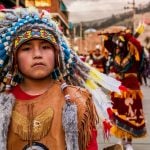The Eastern Woodlands Culture Area
In providing a broad overview of the hundreds of distinct American Indian cultures found in North America, it is common for museums, historians, archaeologists, and ethnologists to use a culture area model. This model is based on the observation that different groups of people living in the same geographic area often share many cultural features.
 The map shown above shows the primary North American Indian culture areas.
The map shown above shows the primary North American Indian culture areas.
According to the display in the Maryhill Museum of Art:
“The Woodlands occupy the entire eastern portion of North America. This large area is often separated into three Sub-Sections: Northeast, Southeast, and Great Lakes. Although the region includes a variety of climate and vegetation, there are underlying similarities among its cultures. Most Woodlands tribes combined agriculture with hunting and gathering. Permanent villages were surrounded by cultivated fields as well as large hunting territories.”
The Northeastern Woodlands is a land of heavily forested rolling hills and rounded mountains, salt marshes of waving grass, calm lakes, tumbling brooks, surf-beaten beaches, and rocky coves. Archaeologists report that Indian people have inhabited this area for more than 10,000 years. About 4,000 years ago the people living in this area began to adopt agriculture.
Among most of the Indian people of the Northeast, most of their food came from the crops which they raised. The three most important crops in the Northeast – corn, beans, squash – were known as the Three Sisters among the Iroquois. The Northeastern Indians raised about 15 different varieties of corn, 60 varieties of beans, and 8 forms of squash.
Prior to the introduction of corn (originally domesticated in Mexico) the Indian nations of the northeast had an agricultural tradition based on domesticated maygrass (Phalaris caroliniana) and goosefoot (Chenopodium berlandieri).
White or purple shell beads, known as wampum, were an important part of the material culture of the Northeastern tribes. The beads were often woven into wampum belts which served as a written record of events, treaties, and laws. When a message was sent from one tribe to another, the messengers would speak upon a wampum belt to indicate that they were speaking truthfully and officially.
The Southeastern Woodlands is an area which is bounded by the Ozark-Ouachita Highlands of Arkansas and Missouri and the dry plains of eastern Texas on the west and the low plateaus of Kentucky and Tennessee and the interior plains of Illinois on the north. The eastern boundary is the Atlantic Ocean and southern boundary is the Gulf of Mexico. The Southeastern Culture Area includes the present states of Georgia, Florida, South Carolina, western North Carolina, Alabama, Mississippi, Louisiana, southern and eastern Arkansas, Tennessee, and the portions of Missouri, Illinois, and Kentucky that border the Mississippi River. Prior to European contact nearly two million Indian people lived in this area.
Five of the Southeastern Indian nations – Cherokee, Chickasaw, Choctaw, Creek, and Seminole – are sometimes called the “five Civilized Tribes”. The designation “civilized” is an indication that they had acquired many elements of European cultures and were the most acculturated Indian tribes during the nineteenth century.
The Great Lakes area was inhabited by Algonquian-speaking tribes such as the Anishinabe (Ojibwa or Chippewa), Kickapoo, Potawatomi, Menominee, Shawnee, Ottawa, and Sauk and by Siouan-speaking groups such as the Winnebago, Iowa, Oto, and Missouria. The Siouan-speaking groups probably emerged from the Oneota cultural tradition that began to flourish about 1000 AD in the upper Mississippi Valley.
Among the Algonquian-speaking people of the western Great Lakes area, farming was of secondary economic importance (hunting and gathering were of greater importance) and contributed less than half of their food. As with the other Indian farmers of the Northeast, they raised corn, beans, tobacco, and squash.
The reduced importance of agriculture was due largely to climatic conditions. Throughout much of the region, the 140 growing day season made agriculture a risky endeavor. A later spring or an early fall meant that crop failures were a constant possibility. There are, however, microclimates along the Great Lakes which offer more suitable conditions for agriculture and offer a slightly longer growing period.
 The shaded area on the map shown above shows the Woodlands culture area.
The shaded area on the map shown above shows the Woodlands culture area.
The Maryhill Museum of Art, near Goldendale, Washington, has a display of Eastern Woodland artifacts.
Basketry


 Shown above is a Paugussett storage basket. This basket, which was made about 1800, has been attributed to Molly Hatchett, a well-known basket maker.
Shown above is a Paugussett storage basket. This basket, which was made about 1800, has been attributed to Molly Hatchett, a well-known basket maker.
Quillwork
 Shown above is an example of quillwork. This small birch bark box has been decorated with porcupine quills.
Shown above is an example of quillwork. This small birch bark box has been decorated with porcupine quills.
Carl Waldman, in his book The Dictionary of Native American Terminology, writes:
“Quills were softened in water or the mouth; flattened by drawing them through the teeth or with a special rock or bone tool called a quill flattener; colored with dyes; and then applied as a form of appliqué on various materials, especially animal skins.”
Beadwork
 Shown above is a pair of Ojibwa moccasins.
Shown above is a pair of Ojibwa moccasins.  Shown above is an Ojibwa bandolier bag.
Shown above is an Ojibwa bandolier bag.




